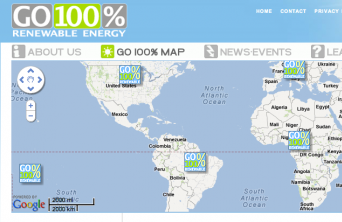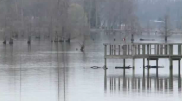Renewables 100 Policy Institute Joins The Intervention
What would the world look like if all the renewable energy projects that aimed for 100 percent of that area's energy needs were charted on a map?
It'd probably look a lot different than the map on this site.
As a kind of friendly antithesis to Counterspill, this interactive map by the Renewables 100 Policy Institute showcases energy projects across the globe working toward replacing 100 percent of non-renewable energy sources with renewable ones.
But, as Diane Moss and Matthias Bank of the organization explain, they're not stopping there.
The organization is really looking to debunk what they view to be a particularly pervasive myth: that going 100 percent renewable is too risky, too unreliable and too expensive.
Many governments adopt programs that aim for much lower renewable energy targets -- 15, 33 or 40 percent -- instead of committing everything to an all-inclusive energy plan. Indeed, the United States has not committed to any target and, of the country's total power supply, about 15 percent was derived from renewable energy sources in 2011.
Renewables 100 Policy Institute says this is unacceptable.
"We need to push the bar to 100 percent -- we've got to go there anyway," says Bank.
Bank and Moss say the lower percentage promises have less to do with economics or infrastructure than just politics.
"They do it because it would be bad for the morale of the politicians to commit to 100 percent," says Moss. "It's a politician's job to be afraid, not an NGO's job to be afraid."
Many NGOs remain undeterred, pioneering energy projects while governments shy away. Even so, says the team, many in the general public don't know don't know what those projects are or what they look like -- and that could interfere with building toward a renewable future.
"We knew we had to show them positive examples and take the fear away about change," says Bank. "People all over the world are doing it and, guess what, their economies are not completely falling apart."
So, the organization set up Go100percent.org to educate the world about it. They've funded most of the project themselves, but the next stage of the project requires a bit more than they can provide on their own.
The main goal of the organization is to get an accurate roadmap study that aims for a future of 100 percent renewable energy in the United States. Although some roadmap studies exist, members of Renewables 100 Policy Institute want something more comprehensive and attainable than what they've seen.
Although they'll take any funding offers, they hope to specifically study a solution for California.
"It's such a large economy here and it's like, if you can do it here, you can do it anywhere," says Moss. "And also it could be a message to California. 'You can take the lead again.'"
"I remember being blown away by California," says Bank. "They were the leader of clean energy, but not anymore."
Back when Bank was involved in renewable energy projects in his home country of Germany, he felt particularly inspired by California. However, recent shifts away from eco-friendly legislation left him wanting to get involved.
And Moss has seen a lot of California's battle herself. She served as an Environmental Deputy to U.S. Congresswoman Jane Harman from 2008 to 2011 and has led her own battles against liquified natural gas plants off the coast of her hometown near Oxnard, Calif.
As for their future, they hope they can continue to coordinate with others to champion real renewable change. But, they say, it won't happen unless nonprofits stick together.
"Sometimes there is this fight between nonprofits or renewable energy organizations about who's going to win," says Bank. "It's just weird. They're dividing themselves instead of uniting."
***
Check out others who have joined the intervention by clicking here! Are you a non-profit organization that would like to join our fight against non-renewable energy? Let us know!






